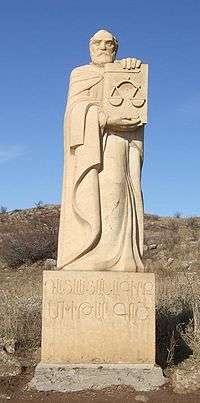Mkhitar Gosh

Mkhitar Gosh (Armenian: Մխիթար Գոշ; 1130–1213) was an Armenian scholar,[2][3] writer, public figure, thinker, and priest. He was one of the representatives of the Armenian Renaissance.[4]
Biography
He was born in the city of Gandzak.[5] He got his early education from public institutions. When he reached his adolescence he decided to dedicate his life to the church. In order to learn theology more thoroughly, Gosh traveled to Cilicia, to the Black Mountains (Սև լեռներ) and studied orthodox theology under the local priests. Upon his return, he, with Zackareh and Ivaneh Zakarian princes' financial help, builds the Ghetik (Գետիկ) church.
He wrote a code of laws including civil and Canon law that was used in both Greater Armenia and Cilicia. It was also used in Poland, by order of king Sigismund the Old, as the law under which the Armenians of Lviv and Kamianets-Podilskyi lived from 1519 until the region fell under Austrian rule in 1772. He also wrote a number of popular fables. He founded the monastery of Nor-Getik which he was later buried. Ever since his death it has become better known as Goshavank. The works of Mkhitar Gosh were later adapted into a Datastanagirk' codex in Middle Armenian, which was prepared by Sempad the Constable, an Armenian noble, military commander, and judge in the 13th century.[6]
| “ | But if you blame this nation of ours with its habits of error and do not correct them, knowing these deeds of the Armenians and at the same time the meansure of their soul, then we cannot be held to blame by you in these matters. So if you engage with our code in a friendly fashion, and you sollicitously complete what is lacking, you will receive compensation from the Lord for your goodness; and through your labours you will store up rational treasures in the churches, and therein a memorial of your kindness will remain for us.—Mkhitar Gosh, Code of laws | ” |
Notes
- ↑ Robert W. Thomson. The Lawcode (Datastanagirk') of Mxit'ar Goš. — Rodopi, 2000. — p. 20:"In any event, his motivation stemmed from the fact that the Armenians of his time did not have a written legal code, and therefore those who wished to settle any legal question had to have recourse to outsiders."
- ↑ Robert W. Thomson. The Lawcode (Datastanagirk') of Mxit'ar Goš. — Rodopi, 2000
- ↑ Antony Eastmond. Tamta's World. — Cambridge University Press, 2017. — P. 126 "At the same time Mkhitar Gosh (d. 1213), the great Armenian jurist, poet and theologian, worked for the Mkhargrdzelis from the monasteries of Getik and then Goshavank, both of which were sited well away from any large settlments."
- ↑ Encyclopedia Americana. — Americana Corporation, 1965. — vol. 2. — p. 270:"The Armenian Renaissance reached its height in this period, with the works of the Vardapet Hovhannes (John) Sarkawag (d. 1129), ... Hetum, author of Narratives of the Tatars and Chronological Tables; Hovhan Erzenkatsi (John of Erzincan), moralist, theologian, poet, and grammarian ; Nerses Lambro- natsi (Nerses of Lambron, 1153-1198), theologian, moralist, and orator ; Mekhitar Gosh (d. 1213), who compiled the Armenian Code"
- ↑ Grave of Mkhitar Gosh
- ↑ "Smbat Sparapet." Dictionary of the Middle Ages
- ↑ Robert W. Thomson. The Lawcode (Datastanagirk') of Mxit'ar Goš. — Rodopi, 2000. — p. 105.
External links
| Wikimedia Commons has media related to Mkhitar Gosh. |
| Wikiquote has quotations related to: Mkhitar Gosh (Armenian Wikiquote) |
- Robert W. Thomson. The Lawcode (Datastanagirk') of Mxit'ar Goš. — Rodopi, 2000
- English translations of Gosh's Fables and his Colophon are available at: http://rbedrosian.com/hsrces.html
- English translations of the Fables and Colophon - mirror if main site unavailable
- Grave of Mkhitar Gosh